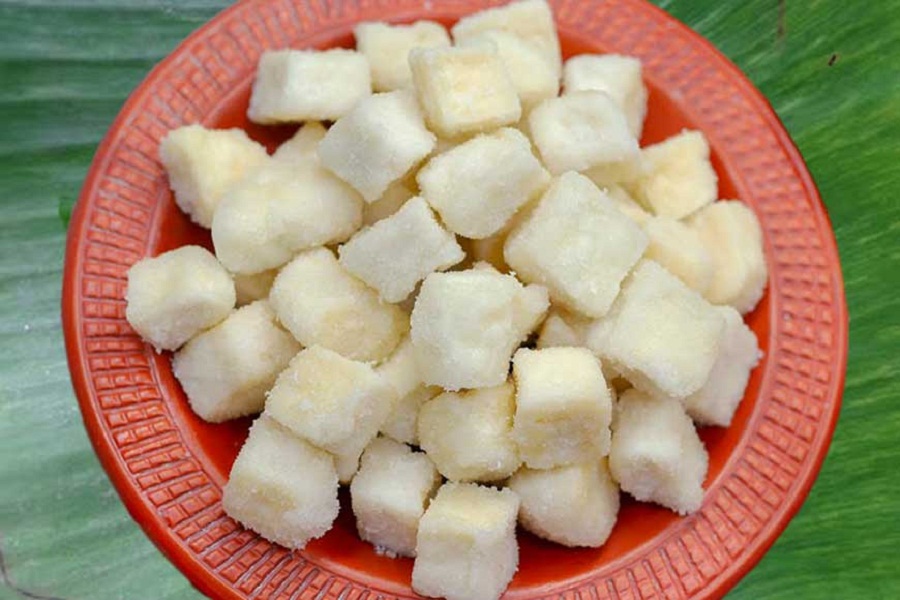
Published :
Updated :

Ever heard of Chhanamukhi? Did you know that Brahmanbaria special Chhanamukhi has been recognised as a GI (Geographical Indicator) product? If you are thinking it's just a sweet, what is the deal about it? Or if you are someone scratching your head thinking what GI means, then this article is for you.
Well, GI products are like Oscars for products, foods and crafts. Bangladesh has a number of 31 GI products now, including Hilsa, Zamdani and Khirshapati aam.
So, what is a GI product?
Suppose something is a GI product. That means that a certain specific product is closely tied to a place of its origin and from where no one can claim to make it quite the same.
It has that particular status as its special quality can only be found in a specific region, and somehow, it's like having a copyright. This is a fancy way of saying this comes from a specific territory and it bears the characteristics of that particular region.
It's like when you hear Darjeeling tea, you picture the hills of India, or pasta reminds you of Italy. As mentioned before, there are 31 GI products in Bangladesh, and recently, Chhanamukhi joined the club. These aren't just important to local culture and tradition but also a source of pride.
What does the GI tag do?
GI products play a significant role in putting places both literally and figuratively on the map. It's not just another level; rather it gives you the advantage to protect your traditional things to yourself and not be copied by some imposters outside the region.
It preserves cultural heritage and boosts the local economy by putting an invisible "Do not copy" stamp on something that has been passed through generations of that specific region.
And in this case, only Brahmanbaria has the authority to claim to produce authentic Chhanamukhi now. Result? Locals can earn more, and the product gets recognition worldwide.
How does GI product impact tourism?
GI products are an absolute game changer for Tourism. Travellers are always in search of uniquely local experiences, and these GI products can attract tourists, given travellers' interest in gastronomic tourism, like flying to Italy for pasta to Japan for Sushi.
This is how GI products can turn a regular town into a hotspot for food tourism, encouraging people to travel miles for an authentic and mouth-watering experience; our own Chhanamukhi just got that golden ticket into the world of satisfying sweet tooth cravings.
What makes Chhanamukhi so unique?
So, what makes it so special making it to obtain a GI tag? Well, obviously, for its unique taste and texture, chhanamukhi got everyone's attention. According to the local confectioner, it takes a whole 7 to 8 litres of pure milk to produce just 1 kg of chhana (a type of cottage cheese).
The process starts with cooking an entire 8 litres of pure milk with 1 kg sugar over a slow fire to give that the chewy and creamiest texture.
When the concoction becomes a thick creamy chhana, it's hung until all the excess water clears up, making the chhana hard.
They then cut that into bite-sized portions. The next steps include making a sugar syrup using water, sugar and cardamom and dropping the smaller pieces of chhana into that syrup.
Lastly they took the sweets from sugar syrup to a wide plate only to dry them naturally. And there you go, the creamiest Chhanamukhi you can ever have. But!
They are the only ones who can make it quite like they make it in Brahmanbaria. It's like the air, weather, water and soil of that region is also part of the recipe, that gives a perfect hit of unique and irresistible flavour.
Its distinctive taste and texture will make you instantly in a food coma. The outside is slightly chewy, whilst the inside is pure bliss of soft and creamy goodness.
Over the years, Chhanamukhi has become a beloved tradition of Brahmanbaria, where they serve this at weddings, festivals and other special occasions. And thanks to the GI status, it's now a national treasure.
How did they come up with the idea of Chhanamukhi?
And the very next thing you may think is how they come up with the idea of tiny drops of heaven. Well, this story starts approximately 100 years back with two brothers, Mahadev Parey and Durgaprasad, living in Kashidham, India.
To seek his fortune, Mahadev moved to Kolkata to work with his brother's sweetmeat shop. When these two brothers were living peacefully, Durgaprasad died, leaving Mahadev all alone and a bit lost.
Given so much happening, Mahadev found himself wandering only to stumble upon Brahmanbaria. Here, fate intervened when Mahadev met Shree Ram Modak, who was apparently the owner of a local sweetmeat shop. Ram saw his potential and gave him a place to sleep and work for his shop. Soon, that shop became the talk of the town, each of them praising the culinary skills of Mahadev and his mouth-watering sweets. Lastly, on Ram's deathbed, he entrusted his shop to Mahadev, where he then only prepared two types of sweets: Lady Canning and Chhanamukhi. The continued fame and Mahadev's culinary skills, along with his legacy of controlling the quality, eventually led Chhanamukhi here on the list of GI products that we know and love. Not just the recipe of Chhanamukhi but also the history is carefully preserved over the years.
Chhanamukhi is more than just tiny drops of heaven or some yummy souvenirs; it's a way to applaud and protect the unique flavours, the backstory and tradition. So, next time when you are visiting Brahmanbaria do not forget to taste Chhanamukhi.
The writer can be found at rahmanmegh1234@gmail.com


 For all latest news, follow The Financial Express Google News channel.
For all latest news, follow The Financial Express Google News channel.